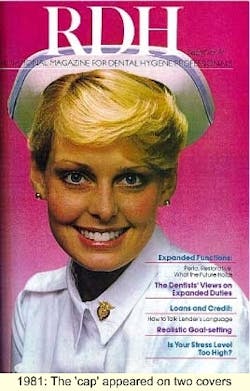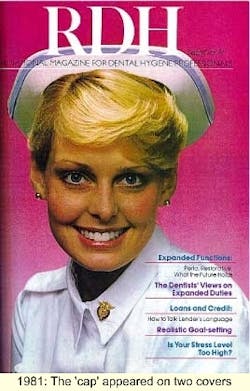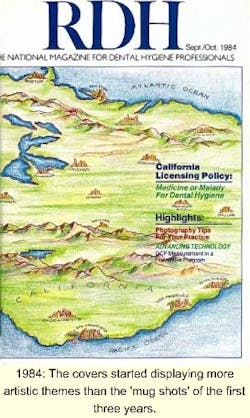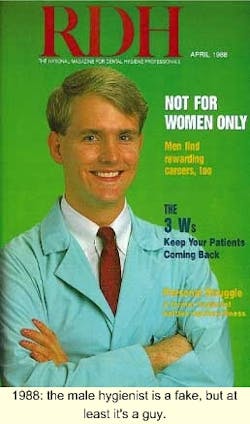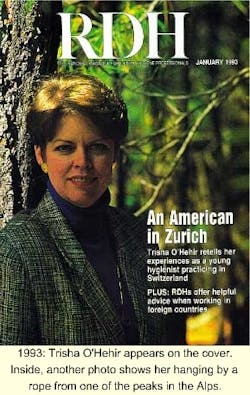It was 20 years ago today RDH came out to play
Editor's Note: The timeline below observes some historical markers in the history of RDH magazine, as well as some funny, sad, or other noteworthy moments. What it does not adequately reflect are the estimated 1,200 feature articles and 1,000 columns that have been printed. These articles were the backbone of the magazine, serving to encourage personal and career growth among hygienists. RDH remains grateful for the efforts of the many authors contributing to the magazine since its beginning in 1981.
January 1981
- Two of the readers believed "independent practice" was necessary. Janay Bongiorno of Michigan observed, "Though the hygienist must be able to call upon the dentist to perform his professional services for her patients, she does not need to practice under his financial jurisdiction."
- Lynda Sabat of Cleveland, Ohio, noted: "The dentist is concerned with the economics of his practice and often finds it advantageous to hire a recent graduate who will work for a lower salary than a more experienced hygienist."
- Marsha Bennett of Illinois wrote: "Our goal is not to do as many prophys as we can. After several years of an endless succession of prophys, one finds oneself trapped in a career that lacks both fulfillment and inspiration."
- Tina Weil of Idaho pointed out: "The basic problem, I think, is that employers feel the salary of the hygienist is higher than most occupations, so our employee benefits should be limited."
Some things never change.
She answered, "My direct response is family pressure. It was important to my parents that I have some sort of profession or trade so that I would never have to be totally dependent upon a husband. I've heard many of my colleagues describe their career choice as 'something to fall back on if my husband turns out to be an alcoholic.' Dental hygiene became the logical choice for my parents to suggest to me..."
Naomi Rhode, the co-founder of SmartPractice in Arizona, was also on the first editorial board. She recently "retired" from RDH to spend more time with her grandchildren.
May/June 1981
July/August 1981
September-December 1981
1982
West recalls, "They wanted me to be the first person to get a bachelor's degree in dental hygiene education. She [the caller] said, 'There will be three faculty and you.' And I said, 'Well, it will be real hard for me to cut class, won't it?' "
1983
But in the September/October issue, Carol-Ann Stentiford of Connecticut talked about an "elderly gentleman" who was one of her patients. If you were not an adult in 1983, you may not realize that the following anecdote would not have been politically incorrect back then.
This 80-something patient always said visiting Stentiford was one of his greatest pleasures, and he would spend "an hour getting ready" for the hygiene appointment. The only pleasure better was beer.
Stentiford wrote, "One day before his appointment, his niece, our receptionist, and I cooled a can of beer. Before his appointment, I prepared the room before bringing him in. I worked until he wanted to rinse. He picked up his cup, took a mouthful, but, unlike his previous habit of quickly expectorating, he held the liquid in his mouth for several seconds. Finally, very slowly, he emptied his mouth. He looked at me and we both started laughing."
1984
1985
1986
- I am proud of what I do for my patients.
- Dental hygiene needs to take control of its destiny.
- We need to have the freedom to practice the full range of skills that have been shown in research to be safely provided by dental hygienists.
The three statements that readers most strongly disagreed with were:
- We should trust [organized] dentistry to take care of us.
- Dental hygiene should stick to clinical issues and continued excellence of service and forget "change."
- I think of myself as a "girl" rather than a "woman."
Woodall retorted, "If your recollections of dental hygiene school are as clear as mine, you remember the hours spent discussing how to record and interpret a health history ellipse Certainly the issue of premedication to prevent subacute bacterial endocarditis was emblazoned on your brain as it was mine. It was a giant red flag waving each time questions regarding rheumatic fever or heart murmur were asked. What amazes me is that the ADA doesn't know we have learned all that. The requirement to learn how to take and interpret a health history can be found in the ADA Commission requirements for dental hygiene education programs."
1987
The text for the ad started off, "If your patients ate raw meat and chewed bones as a regular part of their diets, you could be sure their teeth and supporting periodontium were getting a healthy workout."
1988
The article by Regina Dreyer Thomas, of course, discussed how male hygienists find the profession to be "rewarding" too. One of her sources, Robert Nelson, said, "I find being in a female-dominated profession quite enjoyable. For one thing, the scenery's a lot prettier."
- "Preventive fees will double by 2000."
- "Many hygienists will have attempted the independent practice route only to have found ... alienation from the dental profession."
- "The hygiene facility will be attached, yet separate, much like the atriums on restaurants and hotel lobbies."
- "With increasing numbers of HMOs and PPOs, dentists will seek entry-level hygienists to work at lower salaries on these prepaid patients."
- "All confirmations will be done automatically the day before the appointment by a computer telephone system, much like current wakeup calls of modern hotels."
1989
Senior Editor Irene Woodall likewise bemoaned in her August Commentary, "The question for me is how are we going to get out of the bog of eternal distrust? How can we engage in a meaningful dialogue that does not turn into a father-daughter argument?"
1990
Other noteworthy campaigns included Oral-B's "We should have our head examined" ad and Den-Mat's pronouncements about Rembrandt that featured attractive models in posters.
Hosier said, "My pay, as a child, was a hamburger and fries at my favorite snack stand down the street." Who says dentists don't look for ways to reduce labor overhead?
1991
1992
The article was a profile of Susan Spier, a hygienist who treated patients that fit the preceding description - residents of the Potawatomi Zoo in South Bend, Ind.
1993
1994
1995
1996
1997
About the latter, she wrote in July, "Sometimes you might wonder whether it's a good idea to bounce around so much. When you wake up in the morning, maybe you lie there in bed, unable to decide whether it's a mauve day or a Caribbean-blue one; and think how silly it is to try to juggle your professional life like this."
1998
1999
"In the water, beside me on my right, was a single female dolphin. As she took a breath of fresh air and dove underwater, I did the same. What followed was the profound experience I had asked for. As we dove side by side, she pulled ahead of me, as gracefully as a ballerina. She rolled over on her back and came face to face with me. I found myself gazing directly into her eyes. The emotional impact and love I felt was overwhelming. I could not hold back the tears. They say the eyes are the window to the soul; that is where she touched me."
2000
In May, RDH profiled hygienists with unusual pastimes. One of them, Vicki Buchwald of Illinois, indulges in astronomy, and she wrote: "I tell patients how the telescope is similar to a time machine in that the light of the object you are looking at took tens or hundreds of thousands of years to reach us. Therefore, you see the object the way it was that many years ago."
When you would get home at a quarter to five,
A big feast would wait for you when you'd arrive
No mess to clean up and no dishes to do!
The children would do it, if I ran this zoo!
